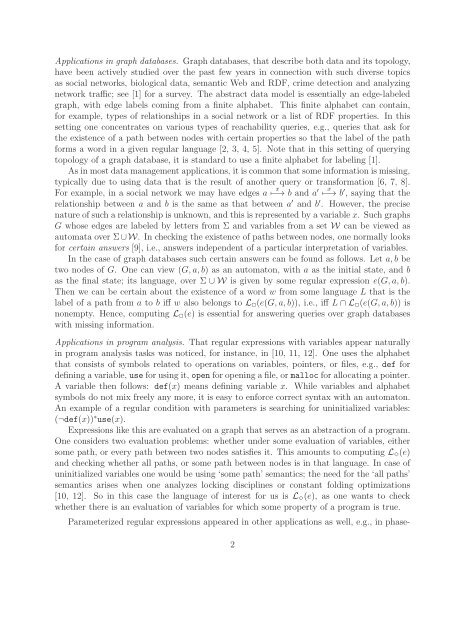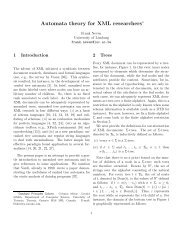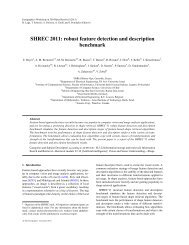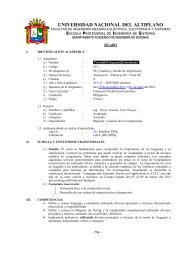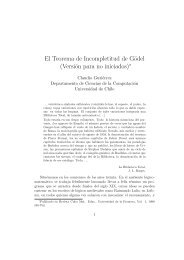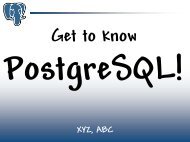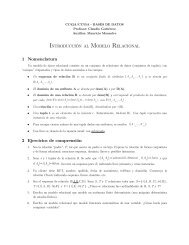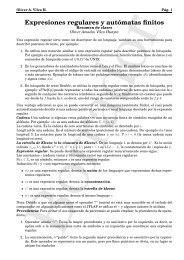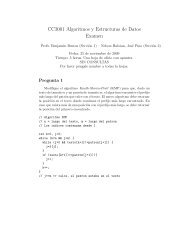Applications in graph databases. Graph databases, that describe both data <strong>and</strong> its topology,have been actively studied over the past few years in connection with such diverse topicsas social networks, biological data, semantic Web <strong>and</strong> RDF, crime detection <strong>and</strong> analyzingnetwork traffic; see [1] for a survey. The abstract data model is essentially an edge-labeledgraph, with edge labels coming from a finite alphabet. This finite alphabet can contain,for example, types of relationships in a social network or a list of RDF properties. In thissetting one concentrates on various types of reachability queries, e.g., queries that ask forthe existence of a path between nodes with certain properties so that the label of the pathforms a word in a given regular language [2, 3, 4, 5]. Note that in this setting of queryingtopology of a graph database, it is st<strong>and</strong>ard to use a finite alphabet for labeling [1].Asinmostdatamanagementapplications, itiscommonthatsomeinformationismissing,typically due to using data that is the result of another query or transformation [6, 7, 8].For example, in a social network we may have edges a ↦−→ xb <strong>and</strong> a ′ x↦−→ b ′ , saying that therelationship between a <strong>and</strong> b is the same as that between a ′ <strong>and</strong> b ′ . However, the precisenatureofsuch arelationship isunknown, <strong>and</strong>this isrepresented by avariablex. Such graphsG whose edges are labeled by letters from Σ <strong>and</strong> variables from a set W can be viewed asautomata over Σ∪W. In checking the existence of paths between nodes, one normally looksfor certain answers [9], i.e., answers independent of a particular interpretation of variables.In the case of graph databases such certain answers can be found as follows. Let a,b betwo nodes of G. One can view (G,a,b) as an automaton, with a as the initial state, <strong>and</strong> bas the final state; its language, over Σ ∪ W is given by some regular expression e(G,a,b).Then we can be certain about the existence of a word w from some language L that is thelabel of a path from a to b iff w also belongs to L ✷ (e(G,a,b)), i.e., iff L∩L ✷ (e(G,a,b)) isnonempty. Hence, computing L ✷ (e) is essential for answering queries over graph databaseswith missing information.Applications in program analysis. That regular expressions with variables appear naturallyin program analysis tasks was noticed, for instance, in [10, 11, 12]. One uses the alphabetthat consists of symbols related to operations on variables, pointers, or files, e.g., def fordefining avariable, useforusing it,openforopening afile, ormallocforallocatingapointer.A variable then follows: def(x) means defining variable x. While variables <strong>and</strong> alphabetsymbols do not mix freely any more, it is easy to enforce correct syntax with an automaton.An example of a regular condition with parameters is searching for uninitialized variables:(¬def(x)) ∗ use(x).<strong>Expressions</strong> like this are evaluated on a graph that serves as an abstraction of a program.One considers two evaluation problems: whether under some evaluation of variables, eithersome path, or every path between two nodes satisfies it. This amounts to computing L ✸ (e)<strong>and</strong> checking whether all paths, or some path between nodes is in that language. In case ofuninitialized variables one would be using ‘some path’ semantics; the need for the ‘all paths’semantics arises when one analyzes locking disciplines or constant folding optimizations[10, 12]. So in this case the language of interest for us is L ✸ (e), as one wants to checkwhether there is an evaluation of variables for which some property of a program is true.<strong>Parameterized</strong> regular expressions appeared in other applications as well, e.g., in phase-2
sequence prediction for dynamic memory allocation [13], or as a compact way to express afamily of legal behaviors in hardware verification [14], or as a tool to state regular constraintsin constraint satisfaction problems [15].Atthesametime, however, verylittleisknownaboutthebasicpropertiesofthelanguagesL ✷ (e) <strong>and</strong> L ✸ (e). Thus, our main goal is to determine the exact complexity of the keyproblemsrelatedtolanguagesL ✷ (e)<strong>and</strong>L ✸ (e). Weconsider thest<strong>and</strong>ardlanguage-theoreticdecision problems, such as membership of a word in the language, language nonemptiness,universality, <strong>and</strong> containment. Since the languages L ✷ (e) <strong>and</strong> L ✸ (e) are regular, we alsoconsider the complexity of constructing NFAs, over the finite alphabet Σ, that define them.For all the decision problems, we determine their complexity. In fact, all of them arecomplete for various complexity classes, from NLogspace to Expspace. We establishupper bounds on the running time of algorithms for constructing NFAs, <strong>and</strong> then provematching lower bounds for the sizes of NFAs representing L ✷ (e) <strong>and</strong> L ✸ (e). Finally, we lookat extensions where the range of variables need not be just Σ but Σ ∗ . Under the possibilitysemantics, such languages need not be regular, but under the certainty semantics, we proveregularity <strong>and</strong> establish complexity bounds.Related work There are several related papers on the possibility semantics, notably [16,17, 18]. Unlike the investigation in this paper, [17, 18] concentrated on the L ✸ (e) semanticsin the context of infinite alphabets. The motivation of [17] comes from the study of infinitestatesystems with finite control (e.g., software with integer parameters). In contrast, for theapplications outlined in the introduction, finite alphabets are more appropriate [1, 4, 10, 11].Results in [17] show that under the possibility semantics <strong>and</strong> infinite alphabets, the resultinglanguages can also be accepted by non-deterministic register automata [18], <strong>and</strong> both closure<strong>and</strong> decidability become problematic. For example, universality <strong>and</strong> containment are undecidableover infinite alphabets [17]. Incontrast, intheclassical language-theoreticframeworkof finite alphabets, closure <strong>and</strong> decidability are guaranteed, <strong>and</strong> the key questions are relatedto the precise complexity of the main decision problems, with most of them requiring newproof techniques.An analog of the L ✷ semantics was studied in the context of graph databases in [7].The model used there is more complex than the simple model of parameterized regularexpressions. Essentially, it boils down to automata in which transitions can be labeledwith such parameterized expressions, <strong>and</strong> labels can be shared between different transitions.Motivations for this model come from different ways of incorporating incompleteness intothe graph database model. Due to the added complexity, lower bounds for the model of [7]do not extend automatically to parameterized regular expressions, <strong>and</strong> in the cases whencomplexity bounds happen to be the same, new proofs are required.Different forms of succinct representations of regular languages, for instance with squaring,complement, <strong>and</strong> intersection, are known in the literature, <strong>and</strong> both decision problems[19] <strong>and</strong> algorithmic problems [20] have been investigated for them. However, even thoughparameterized regular expressions can be exponentially more succinct than regular expressions,it appears that parameterized regular expressions cannot be used to succinctly definean arbitrary regular expression, nor any arbitrary union or intersection of them. Thus, the3
- Page 1: Parameterized Regular Expressions a
- Page 5 and 6: set of variables in V, can of cours
- Page 7 and 8: Lemma 2. Given a set e 1 ,...,e k o
- Page 9 and 10: code an accepting run τ for M on i
- Page 11 and 12: polynomial number of regular expres
- Page 13 and 14: polynomial with respect to E (Mn,1
- Page 15 and 16: • The case where for some 1 ≤ k
- Page 17 and 18: a different variable x i ∈ V. We
- Page 19 and 20: time with respect to the size of A
- Page 21 and 22: Next we show that ϕ is satisfiable
- Page 23 and 24: 3. For each word w ∈ Σ ∗ , the
- Page 25 and 26: Next we show that there is an imple
- Page 27 and 28: Finally, it suffices to perform a r
- Page 29 and 30: that the sequence of configurations
- Page 31 and 32: e 5 6 =⋃(a,q) | δ(q,a)=(q ′ ,a
- Page 33 and 34: 4.4. ContainmentRecall that the Con
- Page 35 and 36: Again, we shall denote this word al
- Page 37 and 38: Given a collection S of words over
- Page 39 and 40: • its size is at most exponential
- Page 41 and 42: states from A e . One reads words o
- Page 43: [20] W. Gelade, F. Neven, Succinctn


